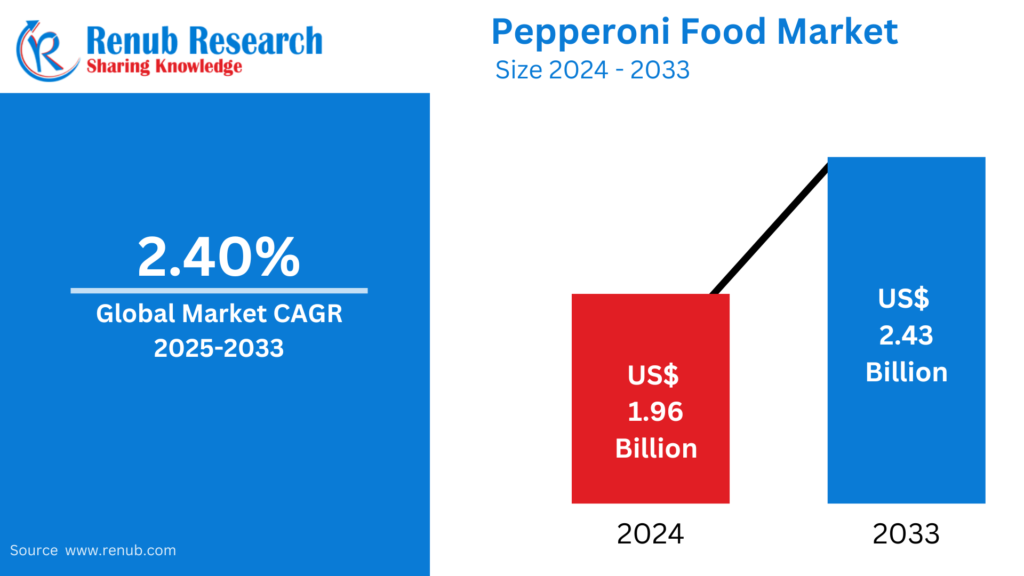Global Pepperoni Food Market Overview
Introduction
Pepperoni is a well-known cured meat product that is often associated with American-style pizza. Made from a combination of pork, beef, and various spices, pepperoni boasts a smoky, spicy flavor that appeals to a wide range of consumers. The global pepperoni food market has experienced steady growth, fueled by its widespread use in pizzas, sandwiches, burgers, and other snack items.
Market Size & Forecast
The global pepperoni food market is projected to reach US$ 2.43 billion by 2033, up from US$ 1.96 billion in 2024, growing at a CAGR of 2.40% from 2025 to 2033. This growth is driven by increasing demand for convenience foods, growing international pizza chains, and the shift towards healthier, plant-based alternatives.
Key Market Drivers
1. Increasing Demand for Convenience Foods
As consumers’ lifestyles become busier, the demand for convenience foods has surged. Ready-to-eat products, such as frozen pizzas, calzones, and sandwiches, have become essential components of the daily food consumption cycle. Pepperoni is a key ingredient in these convenience products, especially in fast food and quick-service restaurants. The growing popularity of frozen pizza and other ready-made meals continues to drive the demand for pepperoni globally.
Example:
In June 2024, Yesway launched Allsup’s Pepperoni Pizza Burrito, combining the familiar flavors of pizza with the convenience of a burrito.
2. Global Expansion of Pizza Chains
International pizza chains like Domino’s and Pizza Hut have expanded their global footprint, further driving the demand for pepperoni. As these chains introduce new menu items and adapt to local tastes, pepperoni remains a staple topping. Additionally, pizza chains are increasingly offering halal-certified pepperoni in regions like the Middle East and Asia, where there is significant demand for this product.
Example:
In May 2023, Hormel Foods Corporation introduced HORMEL Sliced Chorizo, which enhanced the flavor offerings for pizza and sandwiches globally.
3. Healthier, Plant-Based Alternatives
Health-conscious consumers are pushing the market toward healthier alternatives. The rise of plant-based pepperoni, made from ingredients like soy and peas, caters to vegetarians, vegans, and flexitarians. These products align with the global trend toward sustainable, ethical food consumption.
Example:
In July 2024, the Indian brand Plantaway launched plant-based pepperoni and sausages made from pea protein, addressing growing demand for healthier and sustainable food choices.
New Publish Reports
- Europe Food Cans Market Size and Share Analysis – Growth Trends and Forecast Report 2025-2033
- United States Frozen Food Market Size and Share Analysis – Growth Trends and Forecast Report 2025-2033
- North America Baby Food Market Size and Share Analysis – Growth Trends and Forecast Report 2025-2033
- United States Fast Food and Quick Services Restaurants Market Size and Share Analysis – Growth Trends and Forecast Report 2025-2033
- Russia Food Service Market Size and Share Analysis – Growth Trends and Forecast Report 2025-2033
Regional Market Analysis
1. United States Pepperoni Market
The United States remains one of the largest markets for pepperoni, driven by the popularity of pepperoni pizza. The rising demand for convenience foods, including frozen pizzas and ready-to-eat meals, has fueled this market. Furthermore, innovations like low-fat, organic, and plant-based pepperoni are catering to the evolving consumer preferences for healthier and diverse options.
Example:
In October 2024, Hormel Foods Corporation introduced HORMEL Pepperoni Confetti, a product offering a fresh, bold shape that enhanced the flavor of popular dishes.
2. Italian Pepperoni Market
Though traditionally dominated by local meats like salami and prosciutto, pepperoni is becoming increasingly popular in Italy, particularly among younger, cosmopolitan consumers who enjoy bold flavors. Premium and artisanal pepperoni products are emerging in the market, reflecting Italy’s emphasis on high-quality ingredients.
Example:
In August 2024, Genio’s Uncured Pepperoni Pizza used locally sourced ingredients, including hand-torn basil and uncured pepperoni, to cater to premium tastes in the Italian market.
3. Chinese Pepperoni Market
The pepperoni market in China is growing as Western-style foods gain popularity, especially in urban areas. Global pizza chains and local fast-food versions are expanding their presence, driving the demand for pepperoni, particularly as a pizza topping. There is also increasing demand for organic and plant-based pepperoni among health-conscious Chinese consumers.
Example:
In June 2024, Applegate Farms, LLC launched APPLEGATE ORGANICS® Pork & Beef Uncured Pepperoni and APPLEGATE ORGANICS® Turkey Uncured Pepperoni in China, tapping into the growing health-conscious food market.
Market Segmentation
1. By Product Type
- Beef Pepperoni: Typically leaner than pork and widely used for its robust flavor.
- Pork Pepperoni: The traditional choice, known for its rich, fatty texture and flavor.
- Others: Includes chicken and plant-based alternatives.
2. By Application
- Pizza: The most popular use of pepperoni, particularly in North America.
- Sandwiches & Burgers: Pepperoni serves as a key ingredient in sandwiches and burgers, providing a bold flavor profile.
- Dips & Sauces: Pepperoni is increasingly used in dips and sauces for a savory kick.
- Others: Includes snack foods, salads, and pasta dishes.
3. By Distribution Channel
- Supermarkets & Hypermarkets: Large retail chains continue to dominate the distribution of pepperoni, with a wide variety of products on offer.
- E-Commerce: Online sales have become increasingly important, offering consumers a convenient way to purchase pepperoni and related products.
- Specialty Stores: Niche stores that offer gourmet and artisanal pepperoni cater to more specific market segments.
Key Players in the Global Pepperoni Market
- WH Group Ltd.
- Bridgford Foods Corporation
- Tyson Foods Inc.
- Maple Leaf Foods Inc.
- Hormel Foods Corporation
- Golden Harvest Agro Industries Limited
- Simply Good Foods Co.
- Performance Food Group Company
These key players are focusing on product innovation, strategic partnerships, and global expansion to capture a larger market share.
Conclusion
The global pepperoni food market is expected to continue its growth, driven by evolving consumer preferences, the expansion of international pizza chains, and innovation in healthier product alternatives. As the market diversifies, both traditional and plant-based pepperoni options will continue to coexist, catering to a broad range of consumer needs. Additionally, the convenience food trend will further bolster pepperoni demand globally.

